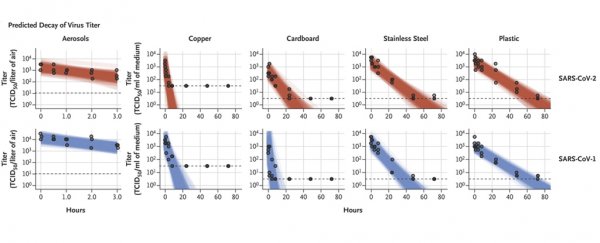The coronavirus responsible for the disease COVID-19 can remain intact on surfaces for a number of days, with studies variously suggesting anywhere from three days to as long as nearly a month.
The precise figure depends heavily on the type of surface infected droplets land on, density of virus particles in the spray, and other environmental conditions - such as temperature and exposure to sunlight.
According to one study conducted by US researchers in March, 2020, the virus may remain detectable and even viable for as long as 72 hours.
Scientists from the National Institute of Allergy and Infectious Diseases, the Centers for Disease Control, Princeton University, and University of California, Los Angeles, experimented with the SARS-CoV-2 virus under laboratory conditions to determine how fast virus particles broke down outside of a host body.
Previous research examining the literature on animal and human strains of coronavirus provided insight into the virus's ability to keep its integrity as it moves through the environment. But until now, experimental evidence on new SARS-CoV-2 has been limited.
The virus behind the 2003 SARS epidemic, SARS-CoV-1, was also tested for comparison, with strains of both pathogens sprayed as micrometre-sized droplets onto various surfaces including cardboard, copper, and plastic.
Just hanging about in the atmosphere, the effect of factors such as UV light and heat causes the mix of RNA, fatty membrane, and protein making up the particles to steadily break down in a few hours.
Dropped onto plastic, the two virus strains appear to be able to stay intact far longer. Only half of the SARS-CoV-2 particles broke apart in just under seven hours, for example, with viable coronavirus particles still detected up to three days later.
Stainless steel was almost as bad, with a half-life for SARS-CoV-2 of 5.6 hours.
Copper, on the other hand, failed to provide similar protection for either strain, with the number of viable particles capable of causing disease vanishing within just four hours for SARS-CoV-2, and eight hours for SARS-CoV-1.
Similarly, on cardboard, no viable SARS-CoV-2 particles could be found after 24 hours, or SARS-CoV-1 after eight.
There are still a number of variables to keep in mind. Variations in individual results show how much the timing is affected by subtle differences.
The laboratory was also kept at a fairly consistent 21 to 23 degrees Celsius, and 65 percent humidity. Just how this latest virus behaves in other conditions of lighting, humidity, and temperature is left to be seen.
Another study published by Australian researchers in October, 2020, suggested the novel coronavirus could last for as long as nearly a month on surfaces such as glass.
This research was conducted on a simulation using a mucus substitute containing a large viral load, placed on various surfaces and held under darkened conditions.
At room temperature, the virus was still detectable 28 days later. It's important to note that this figure doesn't take into account the sterilising effects of sunlight, or the role enzymes in actual nasal mucus could play in breaking down the pathogen.
What does this mean for the COVID-19 pandemic?
While the two precise figures from each of these representative studies conflict, an ability to remain viable for so long on a surface could help us understand why SARS-CoV-2 has spread in such a vigorous fashion.
It's likely ultra-violet light makes a considerable difference in the viability of the virus over a period of exposure. Yet with the possibility of it remaining infectious for a number of weeks, it's important to be vigilant of hygiene practices.
On a more practical front, the study reaffirms the need to disinfect surfaces – especially those made of plastic, glass, and stainless steel (such as phones and other technology) – where possible.
In addition, after touching any of these surfaces, it's important to wash your hands with soap and water.
This research was published in The New England Journal of Medicine and the Virology Journal.
All articles are determined by fact checkers to be correct and relevant at the time of publishing. Information published on the coronavirus during the 2020 COVID-19 pandemic may be updated frequently to reflect the dynamic nature of current understanding.
